If you are asking the question, “Is digital art easy?” it’s pretty obvious you’ve seen a lot of digital art floating around, and it’s inspired you to start digital art yourself.
As an artist myself who’s practiced both – traditional art and digital art, I can honestly say I am glad I made the switch to digital art.
There are several reasons why I feel digital art is more efficient than traditional art, but both types of art have their pros and cons.
There is no wrong choice here.
It all depends on what you are comfortable with as an artist and your preference.
If you are keen on trying out digital art, I highly recommend giving it a shot and seeing if it’s suitable for you before you make the jump.
I know a lot of artists who are incredibly comfortable doing both. I’ll try to give you examples further along in this post.
I started dabbling in digital art in early 2016 because I was a graphic designer, and the jump was somewhat crucial to my career. I enjoyed the process so much that I permanently switched to illustrating and making comics.
I’m going to be covering a lot, so please use the table of contents below to skip to the sections you want to read.
Let’s get started, shall we?
This post includes affiliate links. If you do decide to purchase something, I will make a commission at no extra cost to you. For more information, please read my entire Privacy Policy here.
Table of Contents
What is digital art?

Before we get down to the nitty-gritty, let’s discuss what digital art is in the first place.
Digital art is basically art that is created using technology or digital mediums.
You can use a tablet like an Apple iPad or a Wacom to create digital art, or you can even create mixed art where you draw art on paper using traditional mediums and then transfer it to your computer and edit it.
The minute you use an electronic component to create art, you’ve just made digital art.
All types of art are classified as art at the end of the day.
Digital Art vs Traditional Art

To understand whether digital art is for you, I think you should know all the facts first. So, let’s compare the differences between Traditional Art and Digital Art.
I’m going to weigh the pros and cons so that you can decide which art you’d instead prefer to do.
1. Accesibility to materials
When it comes to traditional art, you need a lot of supplies. If you’re pencil sketching, you need to carry a huge artist’s pouch filled with different types of pencils, blending stumps, erasers, etc. And it can get heavy.
If you’re a watercolor or gouache artist, the number of supplies increases heavily, not to mention your canvases or books or paper.
However, with digital art, you just need your iPad and Apple Pencil or a laptop and a drawing tablet like this one.
I can simply buy some gouache brushes for my Procreate app and get the same effect that I get on a traditional medium.
The number of materials also reduces significantly because all your brushes live on your tablet, which is one reason people prefer digital art over traditional art.
Winner: Digital Art
2. Cost
If you’re looking at traditional vs. digital art in terms of cost, traditional art ends up becoming more costly because of the everyday need for art supplies and materials.
Even if you are a pencil sketcher, you need to invest in drawing books, sketchbooks, and pencils constantly.
Copic markers and gouache paints can be expensive.
Traditional art, in general, requires you to put in a lot of money – especially if you’re working with paints. Whereas if you are a digital artist, you only incur an initial cost of buying a drawing tablet and the software required to draw – like Photoshop or Procreate.
There are also extremely cheap drawing tablets that anyone can get (like this one)and hook to their computer or laptop – so the starting cost isn’t that high if you look at it.
Once you have all of that sorted, there are hardly any costs to digital art whatsoever.
Winner: Digital Art
3. Efficiency
When it comes to traditional art, you need a lot of space, especially for your canvas or notebook and art supplies.

It can get messy. When you’re drawing, your hands will be covered with coal/lead/paints, not to mention your surroundings if you’re not using a newspaper underneath your work.
However, there is no mess and no cleaning up with digital art. You’re just using a stylus on a drawing tablet.
Everything you do is on the drawing tablet itself. So it’s super clean and easy to do. It is more sustainable as well.
So, is digital art accessible when it comes to efficiency? Yes.
Winner: Digital Art
4. Value
Because traditional art is extremely authentic and cannot be replicated easily, it is more valuable than digital art.
You can trace digital art easily. It can be copied and edited, manipulated, duplicated, and distributed, so it definitely isn’t as valuable as original traditional art.
Digital art can also be stolen easily. In this post, Lisa Glanz talks about her experience and how digital products can be stolen easily.
Winner: Traditional Art
5. The process
Artists can feel their art with traditional art.
Whether they’re holding a paintbrush or a pencil, they can feel each stroke when they apply it to their medium. You can blend by rubbing your art with a blending stump or a tissue.
It’s rawer and definitely more engaging.
People who prefer doing art the old-fashioned way will find it hard to move to digital art because it isn’t as tactile as traditional art.
With digital art, you don’t get to mix paints to acquire a new color or touch your art and feel its bumps, it’s extremely straightforward, and perhaps if you’re used to that feeling of pencils on paper, you may miss this a lot.
Winner: Traditional art
6. Portability
This is a no-brainer.
Traditional art is extremely clunky because you literally have to carry all of your art supplies with you when you travel, and it can take up a lot of space in your luggage.
If you are traveling a lot, it will be a little challenging to move around with your notebooks and pencils. It can also become inconvenient to draw at a cafe or an airport – especially if you use paints or markers.
However, with digital art, you only have to carry your drawing tablet and/or laptop, so digital art is definitely a better option for traveling.
I prefer digital art because I can travel anywhere with my tablet, and I usually love drawing in cafes, pubs, and airports.
It’s so convenient and light.
Winner: Digital art
7. Editing
Traditional art isn’t easy to edit or erase. Most of the time, it’s pretty permanent.
Traditional artists really have to be extremely careful when creating art because there is very little room for mistakes. This involves taking more time to plan your art and doing an initial sketch before going in with your paints or pencils.
However, digital art is utterly brilliant because you can undo the previous move and erase whatever doesn’t fit.
You can change colors easily by isolating a particular layer and painting it a different color.
Take this illustration, for example; I can change her swimsuit color from red to green by just manipulating the layer.
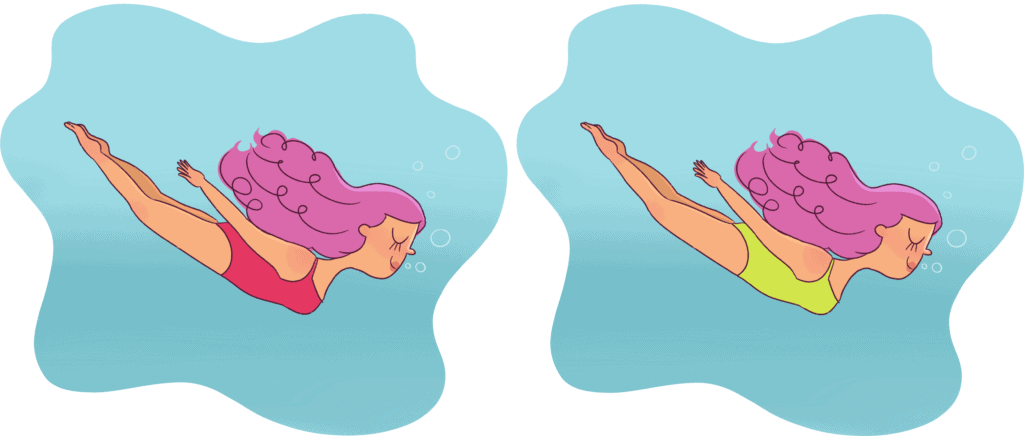
This is how simple it is to edit digital art, which isn’t all that possible for traditional art.
Therefore, digital art is extremely flexible and versatile.
Winner: Digital Art
8. Learning curve
Traditional art is definitely easier to pick up as compared to digital art.
Because you are working with your hands and there is no middle man involved – unlike digital art, where you need to calibrate your stylus and work on your hand dexterity.
Undoubtedly, there is a lot of learning in both mediums – like studying drawing perspectives, color theory, human anatomy, and more, but this becomes common with digital and traditional art.
But digital art does involve a steep learning curve in the beginning because you need to choose a drawing software and then educate yourself on the tools and shortcuts of the software along with learning everything else. It can take some time to figure out. But it’s easier if you get yourself some online courses.
There are so many options available right now, and it can get a little overwhelming in the beginning to pick up.
Winner: Traditional Art
9. Time
Traditional art takes a lot of time.
Because you cannot undo mistakes or erase them easily with traditional art, it is slightly more time-consuming as much planning is involved beforehand.
Digital art, on the other hand, will be slightly faster as you can edit it and make changes as you go along, and even modify your work according to the client’s wishes.
Winner: Digital Art
10. Storage
Traditional art takes up a lot of space. If you are painting and have canvases, you will need more room to store your art.
Digital art, however, can be stored on a laptop or an iPad. You can store unlimited pieces of digital artwork on your computer. And this is a significant advantage!
Just be careful to take backups of your art because you don’t want to lose it all in a hard disk crash.
Winner: Digital Art
11. Convenience
Digital art is portable, so it is more convenient.
Apart from storage, it cannot be easily ruined. Whereas if you are a traditional artist, even your baby touching your artwork or your cat spilling water on your piece can destroy it quickly.
Digital art isn’t easily damaged as compared to traditional art.
Winner: Digital Art
12. Sustainability
Digital art is more sustainable.
You’re not wasting as much paper or using as many resources as compared to traditional art.
This is definitely a significant pro. And if you are a minimalist, the choice is pretty obvious.
Winner: Digital Art
13. Selling
Traditional art requires storage.
And when it comes to selling traditional art, it can be less feasible than digital art because you have to consider multiple factors like inventory and shipping.
However, with digital art, you can sell your work to anyone in the world via email or any online shop.
Digital art, in general, is way more feasible and easy to sell. It’s also easy to get more eyes on digital art since it’s more scalable.
Winner: Digital Art
14. Replication
Traditional art isn’t that easy to replicate or steal. However, it’s increasingly easy to trace over and steal with digital art.
Many digital artists have had their artwork stolen and sold on the black market.
Winner: Traditional Art
15. Dependence on electricity
If the power is out, it becomes incredibly difficult or impossible to work with digital art because you need electricity to create digital art. Even if you have a portable tablet, you will need electricity to charge your tablet.
However, with traditional art, you just need natural light to work. So traditional art definitely triumphs over digital art in this aspect.
Winner: Traditional art
Okay, now that we’ve looked at the pros and cons, let’s move to the factors we need to consider if we want to switch from traditional art to digital art.
Factors to consider if you are switching from traditional art to digital art

1. What is your requirement?
More than all the pros and cons that I’ve just covered, you need to identify what your requirement is.
Digital art has revolutionized the drawing and animation industry because it’s quicker and simpler. It is highly efficient, as compared to the earlier years when animators would have to manually hand-draw each frame.
The introduction of digital art helped the Animation Industries move forward by leaps and bounds! It became so easy to create multiple frames thanks to digital art.
Even now, artists use traditional art to conceptualize characters. Still, once that is done, they use their computers and tablets to draw scenic backgrounds and compose the characters using digital software. So, it is a mix of both types of art.
Digital art makes the process so much easier, and they can finish a movie faster because they can render character movements quickly.
My point is, ask yourself what you like creating. If you want to create fantasy art, or you want to make anime characters, or you want to delve into comic creation and video games, then perhaps digital art is best suited for you.
For instance, I wanted to create multiple illustrations to go with my blog and do covers for eBooks, so digital art was the obvious choice.
2. What are you most comfortable with?
If you are a serious artist or are thinking of making art more than a hobby, then experiment with both and see which one calls to you.
At the end of the day, it depends on your preference. You have to be comfortable with your art and how you create it.
That’s what makes it unique.
You may be a comic artist, in which case you can do both.
For instance, Jen Wang (the Author and Illustrator of The Princess and the Dressmaker) still uses traditional media to create her books. She manually hand draws everything on a 9″ x 12″ Bristol vellum paper with a mechanical pencil. Then she inks everything with India ink and a Raphael Kolinsky or Winsor Newton Series 7 brush.
After that, she scans and colors them with Photoshop using a Wacom Cintiq tablet. You can read more about her illustrating process here.
She also includes a bit of her process at the end of the book – it’s a fantastic book, and you should definitely check it out here!
Look into your requirements personally and ask yourself what you want to do.
As an artist, there are so many ways you can make money online like:
- Selling clipart or designs on Creative Market or Etsy. This online course explains how you can create kawaii clipart and then sell stickers on Etsy.
- Creating Merchandise with your art and selling it online. I took this course by Vania Bachur to learn how to create merchandise with your illustrations on it.
- Creating portraits and commissioned work for clients and companies
- Illustrating and writing a book and selling it (a great source of passive income) – Here’s a great book to help you write and illustrate your own children’s book!
3. Think about where you see yourself in the future
If you want to sell clipart online, you can draw florals via watercolor and then sell prints like this. In this case, you will be using only traditional art.
Or, if you are a pencil sketcher, you can do pencil portrait commissions for clients who want some art depicting their loved ones. In this case, you will also be using only traditional art.
If you’re enthusiastic about creating a digital brand and then selling merchandise with your artwork on it, you can do digital art.
This is one of my favorite courses by Vania Bachur because she teaches you how to find your art style and then create an illustration brand before converting it to merchandise. You even get a certificate at the end of the course!
I suggest looking at some online courses if you’re confused because this will help you see what you can accomplish based on your chosen path.
Or, if you are eager to work with a video game franchise, you can develop characters using digital art again.
The possibilities are endless with both traditional and digital art, and the choice at the end of the day is left up to you.
So, you need to decide what you want to do and then choose accordingly.
What do you need to get started with digital art?

Now, as I said before, there are multiple ways to go about this. Still, I will cover the two most accessible and popular options that digital artists and illustrators prefer.
You can choose what works best depending on your budget and your preference.
Depending on your budget and resources, you can pick whatever works best for you.
1. A laptop/computer with a graphic tablet
If you already have a decent computer and/or a laptop with a good ram so that it can handle Photoshop or any other drawing software, you can just get yourself a drawing tablet.
Then all that’s left to do is to hook it up to the computer/laptop and start drawing.
Personally, I did a lot of traditional art before I started digital art, so I worked for multiple clients and saved up to get my Wacom Cintiq.
Since a Wacom Cintiq has a display, you can see what you draw while you’re drawing it.
But the Wacom Cintiq is a bit pricey, and if you’re looking for a more affordable option, I highly recommend getting a Wacom Intuos.
I have used this too, and you can get it for a pretty neat price!
The Wacom Intuous does not have a display, so you’ll have to look at your computer screen to draw the whole time. This does take some time to get used to because you have to develop a little hand-eye coordination, but it becomes super easy once you get the hang of it!
It’s also much smaller and doesn’t require much space. It will easily fit in your backpack along with your laptop, so this is an excellent option to go for!
2. iPad Pro + Apple Pencil + Procreate
If you are interested in getting into digital art and sticking with it for a long time, I highly recommend getting yourself an iPad Pro and an Apple Pencil.
I upgraded to using these tools in early 2019, and I still use them to make all my digital illustrations!
Why I switched from using a Wacom Cintiq to an iPad?
- Convenience: Procreate is so much easier to use than Photoshop. Photoshop is used for designing, editing and drawing. However, Procreate was created to only draw and paint. It was made with an artist in mind. It’s perfect for creating illustrations and paintings. The brushes are more beautiful and easy to use as compared to Photoshop. You can also get multiple brushes on Creative Market. These are my favorite.
- ProCreate is a tiny one-time fee of $9.99 for the iPad. And that’s it. Your costs are done. However, Photoshop is now a recurring subscription so that does tend to add up over time.
- Portability: All the other drawing tablets need electricity to work. They also require you to connect to a computer. However, with an iPad, you can carry it everywhere along with a pencil. You can go to a cafe or an airport and draw wherever you feel like. So, traveling with an iPad is so much easier!
- Animating: With Procreate, you can create gifs and animations really easily. I took this beautiful class on creating gifs and Illustrations in Procreate to learn how to do this.
- Flexibility. Photoshop takes a long time to learn. But Procreate can be learned in a day or week. There are so many classes for beginners to Procreate and everything is accessible on the main screen. I was able to learn ProCreate in 1 day by watching this class on Domestika. Photoshop isn’t extremely beginner friendly.
Additionally, you can create and save time-lapse videos of your work on Procreate, which is super duper cool!
Having used Photoshop and Procreate, I highly recommend you get an iPad pro and Apple Pencil if you are in love with digital illustrations and want to pursue it as a career or just want it as a hobby.
It’s worth every penny. You won’t regret it.
Moving on…
Is digital art hard to learn?
As I said earlier, digital art takes some time to get used to. I have a post here on how long it takes to learn to draw.
There is a steep learning curve in the beginning because you’re figuring out how to use the software and how to choose which brushes are suitable for your kind of art.
Now, if you have some background in art or a basic understanding of drawing and art, it won’t take much time for you to get used to drawing on a drawing tablet.
However, if you are drawing from scratch, I highly recommend you take these easy step-by-step courses and read these books to help you strengthen your foundation:
- Color Theory – This course will help you understand color composition (very important in digital art) and understand the theory of color so that you can tell a story with your illustrations.
- Human Anatomy – This course will help you learn how the human body is built. Once you know this, you can exaggerate features and draw human beings in a cartoon style easily!
- Procreate 101 – If you already have an iPad Pro, you’re going to want to learn how ProCreate works. I took this course to shorten my learning curve and I was able to figure it out in a day thanks to these online courses.
Online courses will really help you pick up digital art fast! So, if you are interested in becoming a digital artist or an illustrator, do pick up a few courses on Domestika.
You can use my code STRAYCURLS-10 to get a 10% discount on any course you buy.
Because I don’t have a former art degree, I purchased a lot of drawing and illustration books and online courses to help me pick up this skill faster.
I still buy courses and books every month to enhance my learning and become a better artist.
I had a hunger for drawing, so I practiced every day while watching courses. And it really helped me pick up the pace!
But for the purposes of answering your question, “Is digital art easy?” I’m going to walk you through my process of doing digital art.
In this tutorial, I will look at a photograph I found on Unsplash and draw the subject in a cartoon style.
How do you get started with digital art? My digital art process:
Okay, here is a nice photo I found on Unsplash. I enjoy creating colorful illustrations.
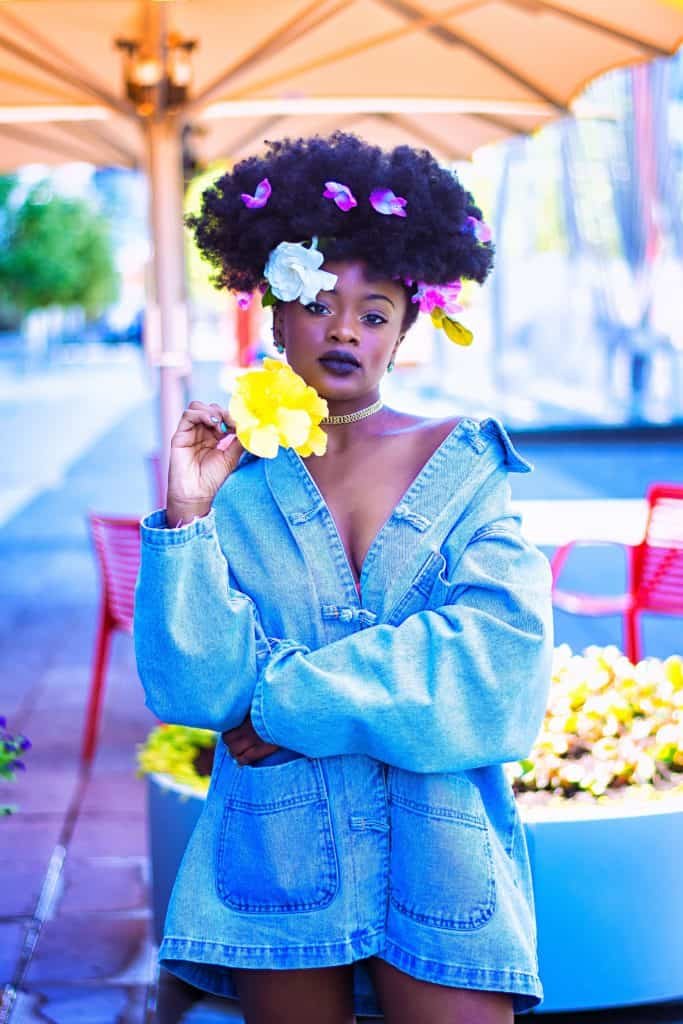
So, now, I will just create a rough sketch while using this photo as a reference. I have two drawing styles at the moment (read this post to learn how to find your art style).
Since my final piece will be digital art, I really don’t need to bother making the pencil sketch perfect.
I still like the feeling of pencil on paper when sketching, so I always do my sketches on paper first before tracing them on the drawing tablet.

As you can see, it’s pretty rough! I’m going to transfer it to my drawing tablet now.
And I will lighten this layer (one of the benefits of digital art is you can use multiple layers) and create a different layer for the sketch. I’m going to change the opacity of the sketch layer to somewhere around 70-80% so that I can see my illustrating process more clearly.
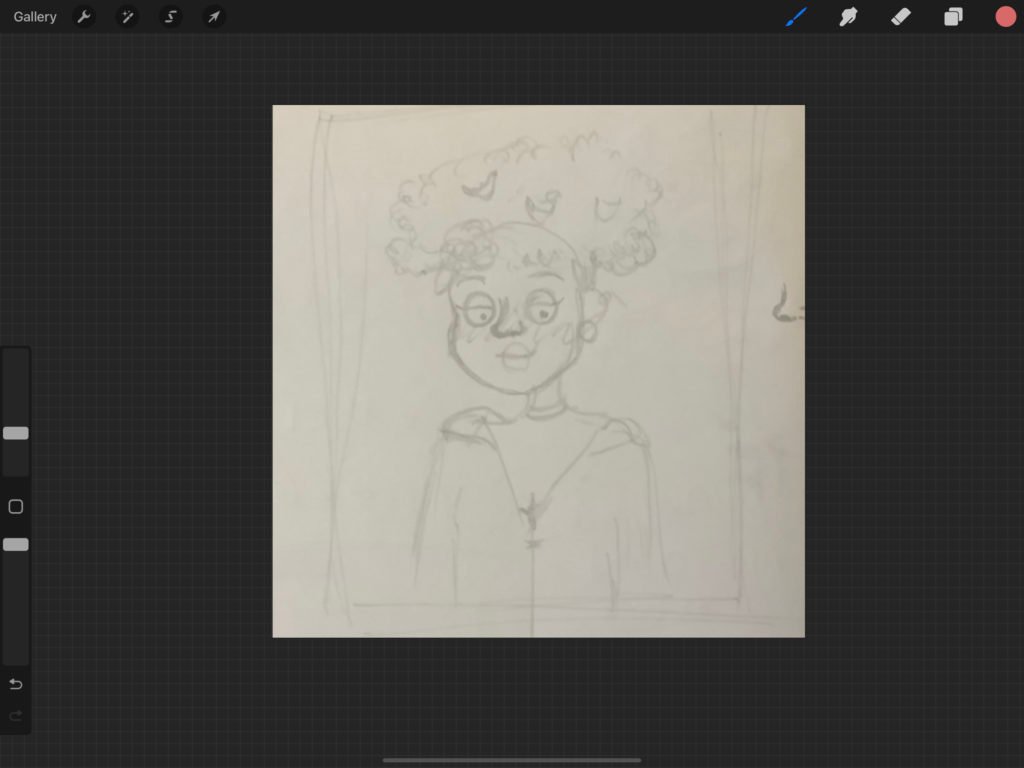
Now, I will draw the outline for the illustration with the dry ink brush on ProCreate. If you’re interested to learn more about ProCreate, check out this course.
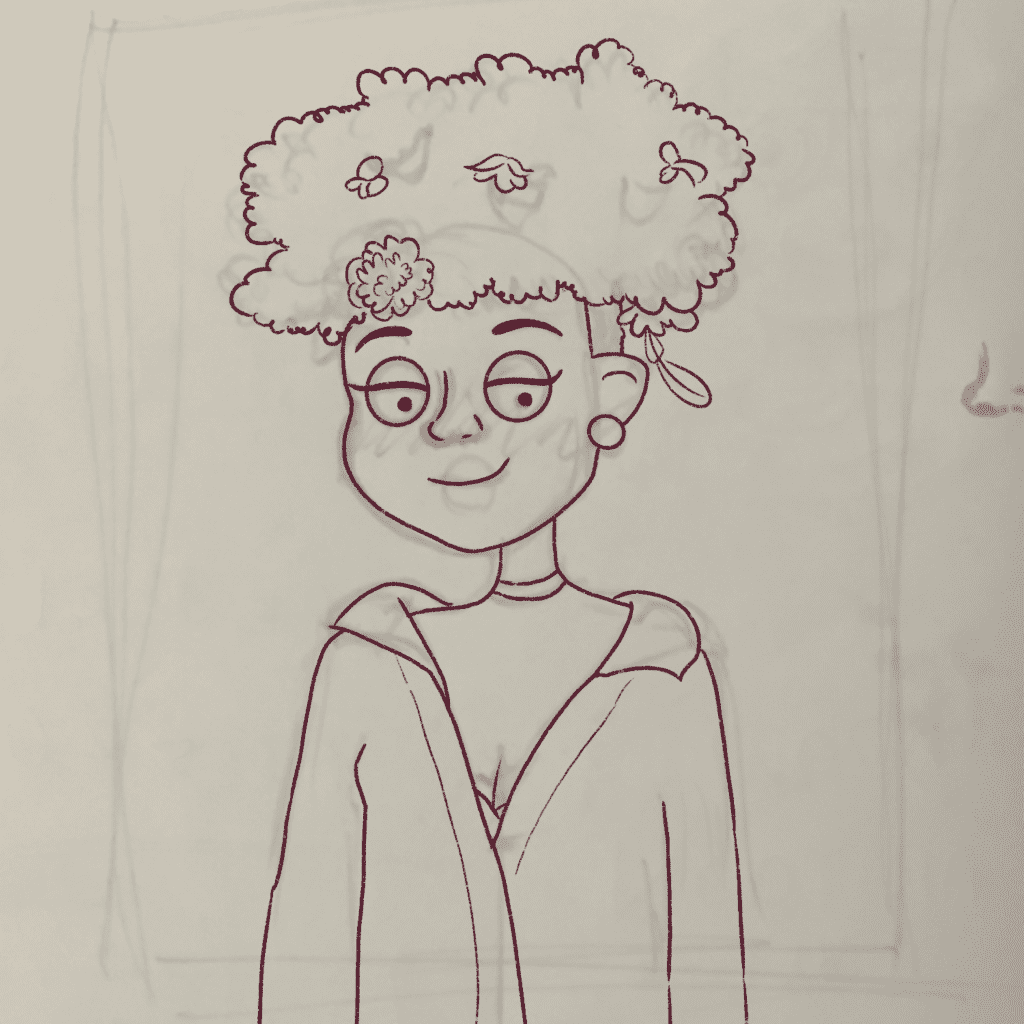
I honestly love this process because it’s so therapeutic. And if you feel like you’re making any mistakes, you can simply undo the move or erase the error. I use a darkish brown or a dark purple shade whenever I’m drawing the outline. You should never use pure black in an illustration.
Once you’re done with the outline, you can delete the sketch layer or hide it because it’s no longer necessary.
Now, I will color the illustration step by step using the same photo as the reference.

This is my favorite part because I love coloring, and I love colors (as you can see from my blog). Once I’m done coloring the illustration, I will add the highlights and shadows.
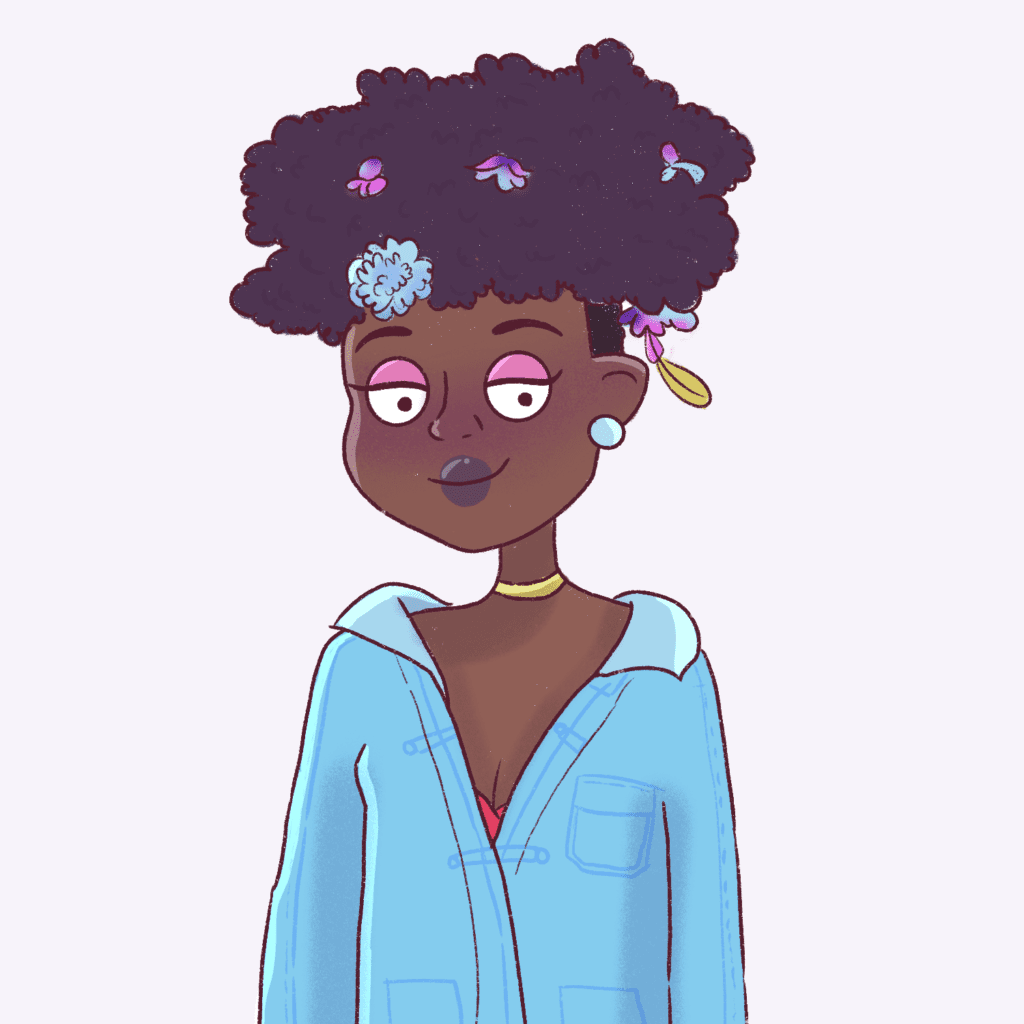
This adds depth to your illustration and really makes it stand out.
Lighting is very important to your illustration or art.
And basically, that’s it. Once you form a process that works for you, it becomes easy to draw digitally. You don’t really have to think much about art. Your hand and mind just take over!
You can watch my process of how I created this illustration in this video.
Is digital art real art?

Yes, digital art is real art!
Let me explain why.
To understand whether digital art is considered art, let’s know the definition of art.
According to Wikipedia, Art is “the expression or application of human creative skill and imagination, typically in a visual form such as painting or sculpture, producing works to be appreciated primarily for their beauty or emotional power.”
Digital art is undoubtedly a visual type of art. Digital art requires you to draw or create with your own perspectives, and you are making a visual piece that people identify with.
And Digital art has a demand today. And there are people all over the world who buy digital art.
It’s more common than you think. Digital art is featured in video games, movies, comic books, magazines, and so much more.
Both traditional art and digital art are done differently using different tools. But that doesn’t mean that one is better than the other.
As I mentioned before, you have to choose which is more suitable for you based on your convenience and preference.
In short, digital art is considered to be real art.
Final Takeaway – Is digital art easy?
Any skill, if practiced enough, becomes easy for a person.
So, is digital art easy? I would say no. But it is easy to do once you pick it up. The pros outweigh the cons, especially if you don’t have space for supplies or like things to be in one place. If you travel a lot or expect to travel a lot, digital art is definitely for you.
I hope this post helped you understand what digital art really is and the pros and cons of digital art versus traditional art.
Both types of art have their advantages and disadvantages, and as I said earlier, there is no right or wrong decision here.
Choosing to become a digital artist is entirely up to you and your comfort and convenience. You need to ask yourself if you enjoy drawing digitally or traditionally before choosing one.
A lot of artists dabble with both and draw digitally or traditionally based on their mood and requirement.
If you have any questions about digital art or becoming an illustrator, please leave them in a comment below, and I’ll be more than happy to help you out!
Resources
If you’ve reached the end of the post, then congratulations – you really do have a strong love for digital art, and you should most definitely pursue it!
I understand taking an art course or studying art professionally isn’t feasible for everyone, especially if you already have a full-time job or are a student juggling many classes.
A lot of people study drawing on the side and work on art as a side hustle till they can draw full-time. So, I will share a couple of resources I used to help me become a better artist and make an income from it.
Books that helped me learn more about drawing:
- How to Draw Anime ( Includes How to Draw Manga, Chibi, Body, Cartoon Faces )
- Making Comics: Storytelling Secrets of Comics, Manga and Graphic Novels
- Sketch Every Day: 100+ simple drawing exercises from Simone Grünewald
- Figure Drawing: Design and Invention
Books that taught me how to make money with my art:
- Draw What You Love: The Art of Simone Grünewald
- Becoming a Successful Illustrator
- Graphic Artists Guild Handbook, 16th Edition: Pricing & Ethical Guidelines
- Art, Inc.: The Essential Guide for Building Your Career as an Artist
Courses that helped me create better art digitally and gave me wonderful business ideas:
- Procreate for Beginners: Digital Illustration 101
- Drawing for beginners
- Female Cartoon Character Design with Procreate
You will need to spend a lot of time learning and drawing if you really want to get started with digital art and become a digital artist.
It really speeds up your progress.
You can take a look at my progress in a span of 4 years. Even though I wasn’t drawing every day because I also wrote a lot, I did draw consistently.

I credit my illustrating skills only to books and online courses. I didn’t really have anyone to teach me, and my learning was entirely self-paced.
The best part about online courses is that you can draw and create while the teacher is doing the same. And you get to compare your work to the teacher’s so you can correct yourself if you’re making mistakes.
It’s a fantastic way of learning step by step, and you get better so much faster!
Currently, I’m doing the same with the piano, but I know I will have to get a teacher later on because you do need someone to teach you at some point if you want to become a professional.
Don’t let anything stop you from pursuing digital art if this is something you want to do.
If I could pick it up, then anyone can.
Digital art is considered real art, and there are people all over the whole commissioning digital art and buying merchandise with digital art on it so you can make a lot of money with your art.
So, break a leg!
If you enjoyed this post, you’d also like:
- The ultimate guide to finding your art style
- 13 signs you are meant to be an artist
- 10 fun drawing gifts to give children below the age of 10
- 13 easy ways to make money online as an artist
- Why do People Like Drawing + Drawing Benefits!
- 9 best drawing books for beginners
- 13 silly drawing mistakes most beginner artists make
- How long does it take for people to learn how to draw? From Newbie to Pro
- How to become a full-time artist without a degree
- How to draw without a reference
Please leave a comment below if you have any questions, I’m more than happy to help!

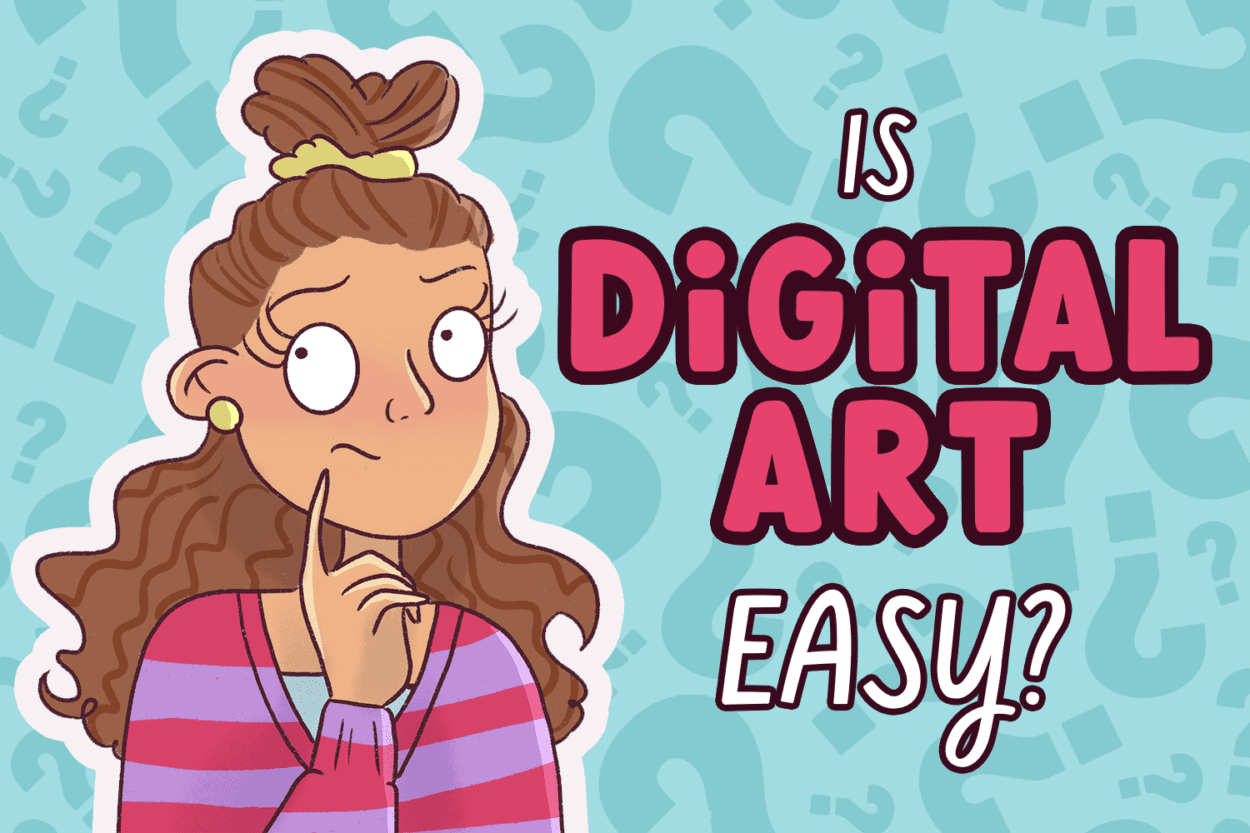

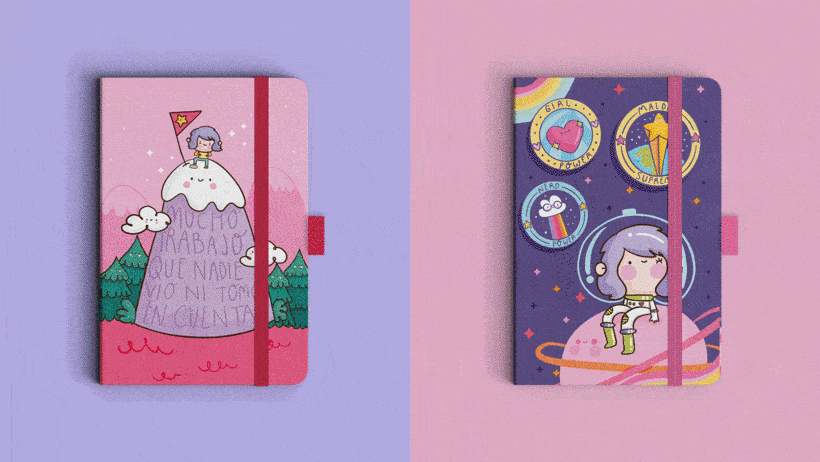

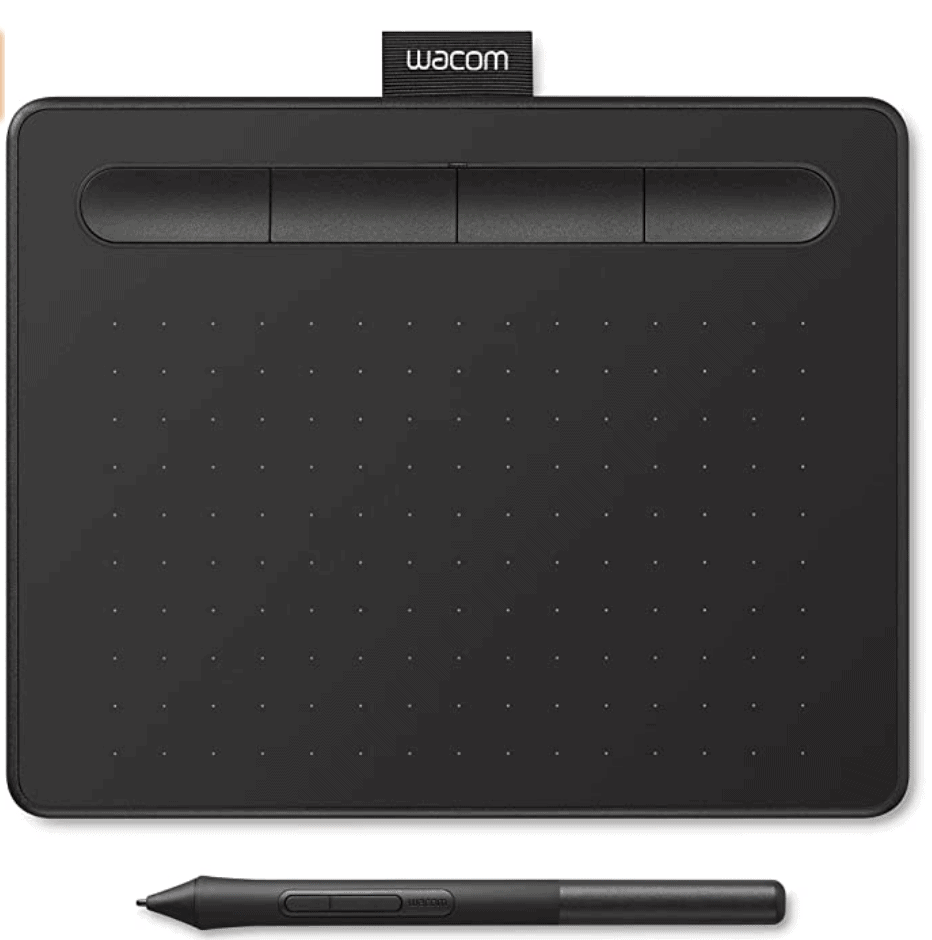

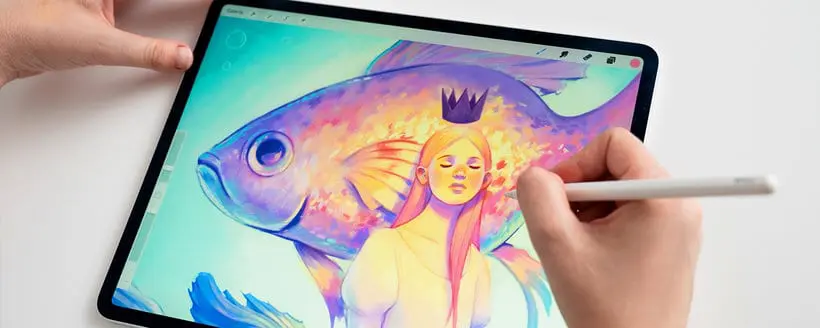
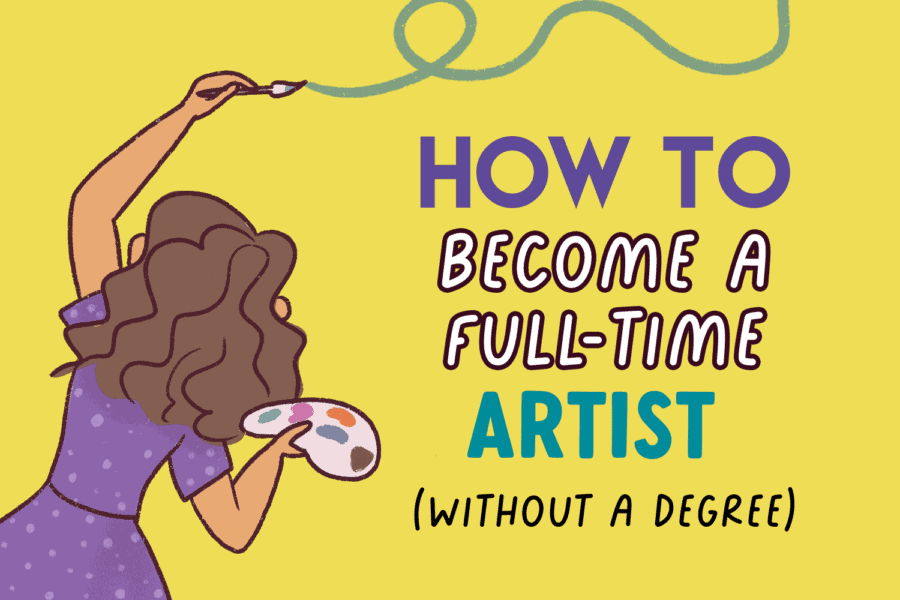
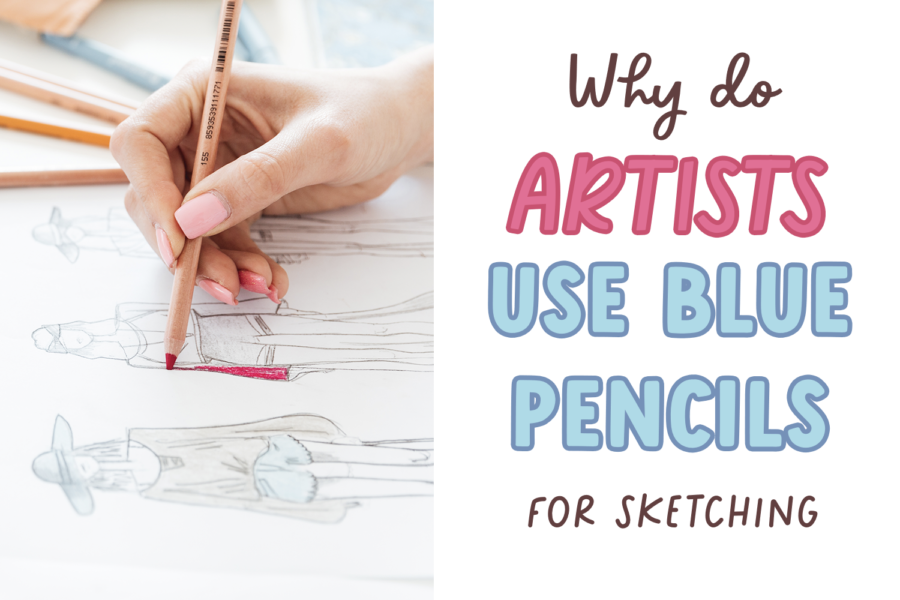


Informative article, It’s very helpful and useful!
I work in Krita, on an XP-Pen Artist 12 2nd Generation display drawing tablet, with their pressure-sensitive pen, which isn’t the best but does ok.
That’s good to know Ibrahim. =) I’ve yet to try out the Krita. I’ve heard a lot about it.